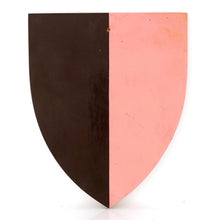From a Collection of Polychromed Cricket Club Shields, 1930
- Regular price
- £65
- Sale price
- £65
- Regular price
-
- Unit price
- /per
Adding product to your cart
Height: 17.2cm (6.7in)
Handpainted on wood. Unidentified.
Percy George Herbert Fender was educated at St. Pauls School and made his first-class debut, for Sussex, in 1910. In 1913 he was picked for the Gentlemen at both Lord's and The Oval, but the next year he switched his allegiance to Surrey for whom he continued to appear until 1935. He was a right-handed batsman and leg spinner, and played thirteen Tests for England. As an amateur he attended to business in the family paper firm before and after each day's play, and often combined Surrey's away matches with business meetings. Socially, Fender was a familiar figure in the clubs and the world of musical theatre. In the curtailed 1914 season, he was chosen as one of Wisden's Cricketers of the Year.

In 1919, having served in the Royal Flying Corps, he was kept out of cricket by a broken leg, but in 1920 he won a place in the MCC touring side to Australia. As an all-rounder he completed the ‘double’ seven times (by scoring a thousand or more runs and taking a hundred or more wickets in first-class matches during the course of a single season). Noted as a belligerent batsman, in 1920 he hit the fastest recorded first-class century, reaching three figures in only 35 minutes, which remained a record until 1983.
On the basis of his Surrey captaincy, contemporaries judged him the best captain in England. A very recognisable figure, the amiable Fender was very popular with his team and the public at large. Cartoonists enjoyed caricaturing his distinctive appearance. Fender later worked in the wine trade, and had a successful career in journalism. He also assisted England captain Douglas Jardine in developing the fast leg theory bowling (Bodyline) to combat the extraordinary batting skill of Australia's leading batsman, Don Bradman during the 1932-33 Ashes Tour. During the Second World War, Fender was commissioned into the Royal Air Force, and, attaining the rank of Wing Commander, was mentioned in dispatches for his role in preparations for the Allied invasion of Europe.




